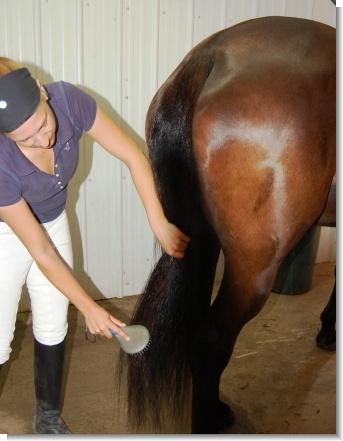Are You Training Your Horse While Grooming or Is He Training You?

Are You Training Your Horse While Grooming or Is He Training You?
You know that in EcoLicious Equestrian we’re all about grooming. And it’s not just about products. Did you know that grooming time is a great way to establish a tone for things to come? I am very excited to share with you the below guest post by Horse Listening. I’ve been enjoying this insightful blog for a while now and highly recommend it, so make sure to stop by and check it out.
Here we go:
Are You Training Your Horse While Grooming or Is He Training You?
Well, of course you are! The real question to pose might be: do you KNOW that you are training your horse while grooming?
We all look forward to grooming our horses; there is no better feeling than having a thousand-pound muscle package wriggle and writhe under your ministrations, roll his eyes, sigh in contentment and offer his mutual-grooming nose in return. It is a time of pleasure for both you and your horse, a time to connect and a chance to put your worries of the day on the back burner and simply “be” with your horse.
However, underneath that feel-good moment, there is a constantly pervasive conversation going on between you and your horse that you may not even be aware of. Horses are physical animals and most of their interactions happen in the physical realm. As humans, we are used to verbal communication and are not as “tuned in” to the physical language of horses as we can be.
Do you know what your horse is saying to you while you whisk away the grime and dirt to reveal the glossy sheen of healthy coat underneath?
HorseSpeak 101 (while grooming)
1. Stepping side-to-side/backwards-forwards: Hurry up and get over with it! He has many more important things to do other than stand around and wait for you to do you “thing”.
2. Pushing you lovingly with his nose: Well, maybe it’s not as loving as you think! He wants to get you to step out of his personal space.
3. Perky-eared cute face presented in anticipation of a treat: He is the herd leader and is demanding that you surrender your feed stuff to him.
4. Pawing on the ground: Similar to #1. He really has no time for you!
5. Tail swish/pinned ears/”the look”: Stop whatever you are doing as it is making him uncomfortable. Beware! There may be a kick or bite coming next. (Note: Horses “think” about biting or kicking many, many times before they actually go through with it; be aware and pick up on the hints before it gets to the point where someone has to get hurt.)
6. Forward pinned ears looking at an object of interest/fear: Watch out! He may jump any second, either on your lap or in the opposite direction. The only thing he is NOT thinking about is you!
What should you do?
In all of the above cases, your goal should be to assert your leadership to your horse. For the sake of your safety and those around you (the horse is, after all, at least 8 times heavier than the average human), you need to firmly explain the boundaries to your horse.
Any pushiness should be met with your insistence that he steps away from you. You may need to push back on his shoulder or hip, or hold him by the halter and swing his hind end away. If he steps in your direction, gently push him away. If he nuzzles up to you (expecting a treat?), tell him your space belongs to you. In all cases, your space is your space and he may not infringe into that area for any reason (not even to snuggle). As a herd leader, you should be the one stepping into his space, not the other way around!
For the horse that paws, move him in such a way that his weight shifts to the pawing foot. If he has to put the foot down, he won’t be able to paw!
For the horse that is giving you a warning: first, identify the source of the problem. If the horse is truly being hurt or irritated by what you are doing, then back off and desensitize him first. Be lighter, quicker, or gentler. Work up to the strength level that you want to use. On the other hand, if the horse is being truly aggressive, then he needs a quick reprimand. Push him away, again asserting your rights to your personal space.
Correctly interpreting your horse’s communications will allow you to have a much deeper and meaningful connection with your horse. If you can act as a calm but assertive leader, your horse will know he is safe with you and will happily hand over the responsibilities that come with being herd boss. He will be less likely to test (although some horses continue to test regularly) and he will be more content overall.
P.S. If you follow the above guidelines, you can set the tone for your upcoming ride while you groom, but that will be a topic for another day!
Ride Green!
The EcoLicious Equestrian
Check out our full line of delicious, natural and green horse care products & horse grooming products at www.ecoliciousequestrian.com.
Share Post
